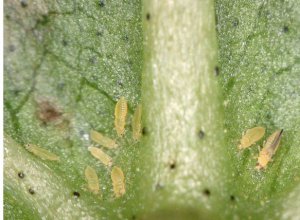It’s harvest season for Florida’s $300 million-per-year strawberry season, so those who grow this fruit need help to control pests such as the tiny (up to 2-millimeters long), destructive chilli thrips.
Farmers often use pesticides to control thrips, but they’d like to minimize those chemicals, and University of Florida scientists may have found a good reason to use pesticides at lower volumes and less frequently.
Chilli thrips usually arrive in Florida strawberry fields after plants bear new leaves, a couple of weeks after they’re planted. Adult thrips come to the strawberry field from nearby crop fields or from vegetation. They feed on new strawberry plants and cause bronzing and darkening of leaves, which stunts the plant’s growth and reduces yield.

When these bugs feed on strawberry plants, they don’t stay in one place.
In a new study, University of Florida research shows chilli thrips tend to stay in one basic area for about two weeks, then move and infect nearby plants. That can be a fortuitous two weeks for growers.
With this finding, farmers can use less pesticide to control the bugs. Farmers who use less pesticide save money on chemicals and help preserve the environment, UF/IFAS scientists say.
“Our findings will reduce the overall input costs of strawberry production and, therefore make Florida strawberry growers competitive in the market with strawberries from Southern California and Mexico,” said Babu Panthi, a former doctoral student in entomology and nematology at the UF/IFAS College of Agricultural and Life Sciences and now a postdoctoral researcher at Oregon State University.
Specifically, the study’s findings mean Florida strawberry growers can reduce the number of insecticide applications by spraying the areas infested with chilli thrips and delay insecticide application by at least a week after they discover the bugs, said Sriyanka Lahiri, a UF/IFAS assistant professor of entomology at the Gulf Coast Research and Education Center (GCREC).
Additionally, the findings should help strawberry growers with their overall approach to mitigate pest damage.
“With very few effective products available for insecticide rotation, this approach will assist with integrated pest management practices to control chilli thrips and create opportunity to include biological control agents more effectively,” Lahiri said.
Panthi cites these reasons to reduce insecticide use:
- Excessive reliance on chemical insecticides is not sustainable to control thrips.
- Strawberry growers must determine whether limited applications of highly effective insecticide products per season should be used against chilli thripsearly in the season or reserved for flower thrips later.
Because chilli thrips confine their damage to Florida strawberries, these findings impact only the state’s growers. But because it’s an invasive species that’s rapidly expanding its geographic range, strawberry growers in other U.S. states can learn and prepare to manage this pest in the future, Lahiri said.
Panthi did his doctoral studies under the supervision of Lahiri, Justin Renkema, a former UF/IFAS assistant professor of entomology at GCREC and Oscar Liburd, an entomology Professor at UF/IFAS in Gainesville. His research wasn’t limited to a pesticide finding. Panthi looked at managing chilli thrips from a wider perspective.
“I established a threshold for chilli thrips and developed a sampling plan to make control decisions,” Panthi said. “Such a plan allows growers to make accurate control decisions with fewer samples compared to whole field scouting and avoid making unnecessary insecticide applications. This is more important for Florida strawberry growers since the early-season chilli thrips population is not widespread in the field and still low to cause any significant damage.”
-30-
The mission of the University of Florida Institute of Food and Agricultural Sciences (UF/IFAS) is to develop knowledge relevant to agricultural, human and natural resources and to make that knowledge available to sustain and enhance the quality of human life. With more than a dozen research facilities, 67 county Extension offices, and award-winning students and faculty in the UF College of Agricultural and Life Sciences, UF/IFAS brings science-based solutions to the state’s agricultural and natural resources industries, and all Florida residents.
 0
0
